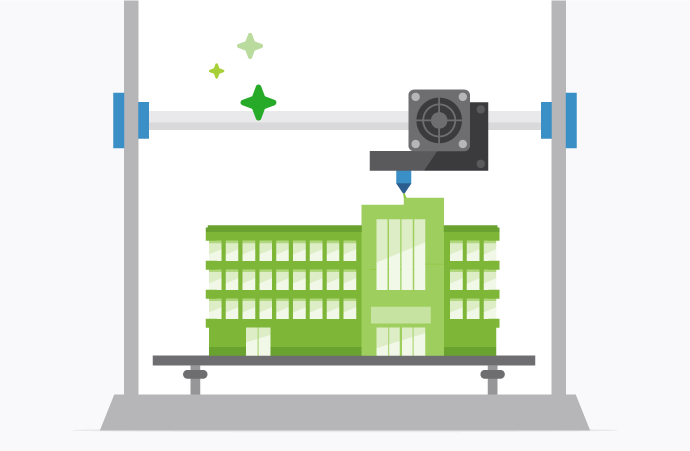We’ve written before about how to get people using your 3D printing lab . But what happens when they, you know, actually start using your 3D printing lab? Growing demand is great, especially when you’ve set up a proper payment system, but it does raise the question of scale and efficiency. The more people using your 3D printing lab, the smoother and more organized it needs to be. At a certain point, it’s no longer enough to have one very stressed employee answering emails and handling walk-up requests – you need a dedicated 3D printing workflow.
And that’s what we’ll be chatting about today: how to turn your 3D printing lab from a random collection of resin printers into a lean, mean, 3D printing machine.
What makes a good 3D printing lab?
A well-run 3D printing lab should be safe, fast and efficient. It’s not hard to get there, but you do need to factor a few things in. Building a slick order entry system; keeping all your comms in one place; giving up-to-date feedback on print times and job progress; and of course, making payments easier (both for users and the poor person handling accounts).
The good news is, most of these can be achieved with the right 3D printing solution. PaperCut MF 3D printing , for example, is basically your end-to-end 3D printing workflow manager. Combine that with the right staff, and a few on-site adjustments we’ll discuss below, and you’ll have a scalable 3D print lab in no time.
Get the 3D printing inputs right
Half the battle with 3D printing is the input process. Get that bit right and you make life much easier for yourself. The first step is minimizing errors in your order entry.
A well-designed order entry system should guide users to order 3D printing services you offer. It should also avoid strange printing combos that you can’t fulfil. Our tip? Spend the time to carefully craft the way your lab presents it’s ‘products’. The goal is to reduce the number of interactions you need to have with a user to understand what they’re actually after. It’s better for your staff, but also a much better experience for users.
If you’ve got PaperCut MF, try using the existing 3D printing order templates to streamline things. You’ll find these in the Operator Interface. Just go to Settings > Products > Create Product and then select Import From Template.
Consolidate 3D printing communications
“Where did I put that sticky note with that job from last Thursday?” If you’re asking yourself these kinds of questions, you need help. Having information about 3D printing jobs scattered throughout your inbox – or even worse, on paper – is a sure-fire way to miss jobs and annoy users. It can also result in a lot of unnecessary work.
We recommend using a single system where new 3D printing orders come in, a place where design files across revisions are kept, and where all internal and external notes can be viewed and shared. That way you’ll always have the most up-to-date info about a job before you start printing.
With the right 3D printing solution, like PaperCut MF, you should be able to place internal comments on specific jobs. That way everything stays together.
Give 3D printing feedback
As your 3D printing lab gets busier, wait times are going to stretch out. And that’s actually okay. You’ve got a finite number of printers, not to mention time in the day, and orders may not be filled at the speed they used to. The important bit, and we can’t stress this enough, is simply to let people know. Communicate job timelines. Set expectations. Users only get upset when the timeline in their head doesn’t match up to reality.
So how do you make sure users have up-to-date, real-time information about the progress of their 3D printing jobs? Simply customize automatic notifications in your 3D printing management software. Check out our PaperCut MF manual for more info. Trust us, you’ll field fewer calls, and users can check progress on their own time (not yours).
Make 3D printing payments simple
So you’ve started charging for your 3D printing services. That’s great! 3D printing labs can be quite the little earners, if run correctly. Problems tend to arise, however, when payments are still a manual step. We see this one all the time. A true 3D printing solution should automate jobs and payments, so you can spend more time running your 3D printing lab and less time looking at spreadsheets.
With an end-to-end print management solution, like PaperCut MF, you can quickly setup users with individual quotas and credit. When they log a print job, their account is debited automatically. When they run out of money, they can top up themselves online. Check out our User Management guide for more info.
Integrate 3D printing with paper printing
Remember, your 3D printers do not exist in isolation. They form part of your overall IT infrastructure. So if you need to account for usage, it’s best to track it using your traditional printing systems. Think about it: you’re already tracking the use of your paper printing, so why not add 3D printing into the same reports?
Using the systems you have is the easiest way to simplify how you work. Get rid of the administrative overhead – no separate spreadsheets, no taking cash payments.
Streamline your 3D printing pickups
Streamline 3D printing pickups by having a set location where users go to pick up their jobs. In a trusted environment, this is one of the easiest ways to reduce time spent by lab staff searching for jobs and handing them out. By setting a bin number or locker position, you can easily notify students which bin their jobs will be placed in for collection, even if collection needs to happen at some awkward hour of the day (or night).


